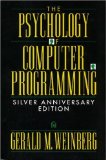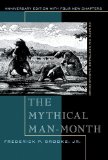What is it that sets apart a top-notch IT executive from others of his calling? To my mind, one mark of today’s true professional, especially at the senior executive level, is to be deeply familiar with the seminal books in his or her field. The dilemma for an IT professional, though, comes from the ongoing and increasing flood of books to choose from, and trying to figure out how to walk the fine line between focus on the intensely tactical and focus on higher-level concepts and ideas.
The tactical books do have their place on your shelf, actually, and it would be a mistake to ignore them simply because you’ve moved beyond daily application of your development, configuration, and technical trouble-shooting skills: judicious selection and absorbing of nuts-and-bolts techniques and new approaches will keep your insight into technology and its possibilities fresh.
I started in IT as a developer, and I remain fascinated by the endless possibilities and techniques of the world of software. In the last decade or two, though, I’ve become even more intrigued by a metalayer above the more tactical concerns. True to my ongoing insistence that the biggest challenges in IT aren’t purely technical, I am ever more convinced that the greatest difficulties are presented by “psychology of IT” issues: the human factors in how software and systems are conceived, built, tested, deployed, maintained, and eventually decommissioned. Here are just a smattering of the eternal, non-technical questions that go far beyond the computer language du jour or the latest hot methodology:
- How do teams actually create and complete information technology projects? What works, what fails, and why?
- Why are some software developers supposedly ten times as productive as others?
- Why do some software teams gel and others don’t?
- Why do small companies with very few resources often beat out large, well-funded efforts in the marketplace?
- How technical should managers be?
So starting with this post, let’s embark on a multi-part survey of the groundbreaking, timeless books on such issues. I’m going to pick what I consider to be the top three books from each decade, starting with the 70s. Each of them deserves not only a place on your bookshelf, but to be read and reread every few years. And contrary to what one might think, their insights remain not only valid after all these years, but have become all the stronger by having been confirmed by the history of the industry since their publication.
- Weinberg, The Psychology of Computer Programming (1971)

Weinberg opens with, “This book has only one major purpose—to trigger the beginning of a new field of study: computer programming as a human activity…. If our experiences are any indication, each [software developer] could be functioning more efficiently, if he and his manager can learn to look upon [him] as a human being, rather than as another one of the machines.” This book was especially groundbreaking by addressing software development as both an individual and a team effort. Remarkably readable and full of anecdotal examples, it covers virtually every human aspect of the software development “sausage factory”: team formation, individual contributions, goal setting, leadership, estimating. Weinberg’s “Silver Anniversary” edition of this book contains annotations and commentary for each chapter, reflecting on similarities and differences to today’s environments.
- Brooks, The Mythical Man-Month (1975)
 I’ve said it before: if there’s one single book that every IT professional should read, it’s this one. Brooks’ foreword presents it as a “belated answer to Tom Watson’s probing questions as to why programming is hard to manage.” Brooks’ writing brims with key universal concepts that can be unfortunately non-intuitive to people outside the field, but which ring familiar to any long-time IT practitioner. The titular essay introduces the concept of the “mythical man-month”, his adage that “adding manpower to a late software project makes it even later.” But there’s much more, such as “plan to throw one away”, where Brooks points out that the “first system built is barely usable; … there is no alternative but to start again.” I can’t say enough about this book. As with the Weinberg book, the anniversary edition now being sold includes extra material: Brooks’ later (1986), equally seminal essay, “No Silver Bullets” (see my post on this: “No Silver Bullets. Really!“), as well as some added chapters that revisit the assumptions of the first edition.
I’ve said it before: if there’s one single book that every IT professional should read, it’s this one. Brooks’ foreword presents it as a “belated answer to Tom Watson’s probing questions as to why programming is hard to manage.” Brooks’ writing brims with key universal concepts that can be unfortunately non-intuitive to people outside the field, but which ring familiar to any long-time IT practitioner. The titular essay introduces the concept of the “mythical man-month”, his adage that “adding manpower to a late software project makes it even later.” But there’s much more, such as “plan to throw one away”, where Brooks points out that the “first system built is barely usable; … there is no alternative but to start again.” I can’t say enough about this book. As with the Weinberg book, the anniversary edition now being sold includes extra material: Brooks’ later (1986), equally seminal essay, “No Silver Bullets” (see my post on this: “No Silver Bullets. Really!“), as well as some added chapters that revisit the assumptions of the first edition.
- Weizenbaum, Computer Power and Human Reason (1976)
 Ultimately, this is a book about the limits of computers and software. Weizenbaum, a noted computer scientist in the early days of Artificial Intelligence research, wrote a program called ELIZA, featuring a script that “enabled it to parody the responses of a nondirective psychotherapist in an initial psychiatric interview.” In other words, his test subjects would converse with a software program that emulated a therapist. Weizenbaum became horrified by how many people forgot that this was “just” a machine they were talking to, and that the dialog was really just an illusion. Many insisted, to his amazement and despite his explanations, that the computer actually understood them.
Ultimately, this is a book about the limits of computers and software. Weizenbaum, a noted computer scientist in the early days of Artificial Intelligence research, wrote a program called ELIZA, featuring a script that “enabled it to parody the responses of a nondirective psychotherapist in an initial psychiatric interview.” In other words, his test subjects would converse with a software program that emulated a therapist. Weizenbaum became horrified by how many people forgot that this was “just” a machine they were talking to, and that the dialog was really just an illusion. Many insisted, to his amazement and despite his explanations, that the computer actually understood them.
IT professionals today can be just as swept away, to a fault, with the potential ultimate power of software and systems as Weizenbaum describes. I’m inspired and reinvigorated every time I read his sobering, methodical discussion of the nature of programming, the limits of its scope, and the need to consider the social implications of technical projects.
The next time, I’ll be on to the key books of the 80s. I’ve already picked the books I tentatively plan to write about, but I welcome your suggestions.
Lagniappe:
Here are a couple of books that didn’t quite fit in my theme and chosen time frame, but which are still worthy of mention:
- Thomas Kuhn, The Structure of Scientific Revolutions (1962)
Nobel Prize-winning physicist Steven Weinberg wrote that this book “has had a wider influence than any other book on the history of science.” This book is not about information technology directly, but its influence has been monumental across all scientific disciplines, and it is a book that any technologist should know well.
- Ted Nelson, Computer Lib/Dream Machines (1974)
This was a self-published book in the early 70s, by influential industry visionary Ted Nelson, the man who coined the term “hypertext.” It’s probably different from just about any book you’ve ever read.

Great post! I was pleased to see “The Mythical Man-Month” on the list as I expected it to appear after only reading the first two paragraphs. Looking forward to the rest of the series to see perspectives on books that make the cut and why.
Now where did I leave my library card???
One interesting book for historical reasons is Richard L. Nolan’s Managing the Data Resource Function (1974). CACM review: http://portal.acm.org/citation.cfm?id=1017558.1017564. It is the earliest volume I can find on the subject of large scale enterprise IT management (as opposed to engineering, development, etc.).
-Charlie
You missed one in your Lagniappe section! No, it doesn’t apply directly to the theme of human factors in IT, but still, it influenced me very much: it’s Robert Pirsig’s Zen and the Art of Motorcycle Maintenance, which I believe was published in 1974. Its discussion of quality (classical and romantic) is something every developer should read and ponder.
Interesting comments — Charles, I’m going to take a look at that book by Nolan. You’ll see another book of his show up on my list for a later decade, assuming my current plans hold.
Harry, Zen and the Art is one of my favorite books, although it’s often a difficult slog for the casual reader. Thanks for mentioning it!
PS there are two editions, both readily available on Amazon –